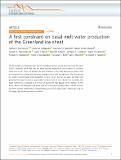Files in this item
A first constraint on basal melt-water production of the Greenland ice sheet
Item metadata
| dc.contributor.author | Karlsson, Nanna B. | |
| dc.contributor.author | Solgaard, Anne M. | |
| dc.contributor.author | Mankoff, Kenneth D. | |
| dc.contributor.author | Gillet-Chaulet, Fabien | |
| dc.contributor.author | MacGregor, Joseph A. | |
| dc.contributor.author | Box, Jason E. | |
| dc.contributor.author | Citterio, Michele | |
| dc.contributor.author | Colgan, William T. | |
| dc.contributor.author | Larsen, Signe H. | |
| dc.contributor.author | Kjeldsen, Kristian K. | |
| dc.contributor.author | Korsgaard, Niels J. | |
| dc.contributor.author | Benn, Douglas I. | |
| dc.contributor.author | Hewitt, Ian J. | |
| dc.contributor.author | Fausto, Robert S. | |
| dc.date.accessioned | 2021-06-21T16:30:05Z | |
| dc.date.available | 2021-06-21T16:30:05Z | |
| dc.date.issued | 2021-06-08 | |
| dc.identifier | 274557566 | |
| dc.identifier | 0fdc7569-2446-42b7-a478-ff1f0197e073 | |
| dc.identifier | 000664856900019 | |
| dc.identifier | 85107680691 | |
| dc.identifier.citation | Karlsson , N B , Solgaard , A M , Mankoff , K D , Gillet-Chaulet , F , MacGregor , J A , Box , J E , Citterio , M , Colgan , W T , Larsen , S H , Kjeldsen , K K , Korsgaard , N J , Benn , D I , Hewitt , I J & Fausto , R S 2021 , ' A first constraint on basal melt-water production of the Greenland ice sheet ' , Nature Communications , vol. 12 , 3461 . https://doi.org/10.1038/s41467-021-23739-z | en |
| dc.identifier.issn | 2041-1723 | |
| dc.identifier.other | Jisc: 39ea4ff68e014038bdfb60e464e29d66 | |
| dc.identifier.other | publisher-id: s41467-021-23739-z | |
| dc.identifier.other | manuscript: 23739 | |
| dc.identifier.other | ORCID: /0000-0002-3604-0886/work/95418368 | |
| dc.identifier.uri | https://hdl.handle.net/10023/23403 | |
| dc.description | PROMICE is funded by the Geological Survey of Denmark and Greenland (GEUS) and the Danish Ministry of Climate, Energy and Utilities under the Danish Cooperation for Environment in the Arctic (DANCEA), and is conducted in collaboration with DTU Space (Technical University of Denmark) and Asiaq, Greenland. | en |
| dc.description.abstract | The Greenland ice sheet has been one of the largest sources of sea-level rise since the early 2000s. However, basal melt has not been included explicitly in assessments of ice-sheet mass loss so far. Here, we present the first estimate of the total and regional basal melt produced by the ice sheet and the recent change in basal melt through time. We find that the ice sheet’s present basal melt production is 21.4 +4.4/−4.0 Gt per year, and that melt generated by basal friction is responsible for about half of this volume. We estimate that basal melting has increased by 2.9 ± 5.2 Gt during the first decade of the 2000s. As the Arctic warms, we anticipate that basal melt will continue to increase due to faster ice flow and more surface melting thus compounding current mass loss trends, enhancing solid ice discharge, and modifying fjord circulation. | |
| dc.format.extent | 3473802 | |
| dc.language.iso | eng | |
| dc.relation.ispartof | Nature Communications | en |
| dc.subject | GE Environmental Sciences | en |
| dc.subject | DAS | en |
| dc.subject.lcc | GE | en |
| dc.title | A first constraint on basal melt-water production of the Greenland ice sheet | en |
| dc.type | Journal article | en |
| dc.contributor.institution | University of St Andrews. School of Geography & Sustainable Development | en |
| dc.contributor.institution | University of St Andrews. Bell-Edwards Geographic Data Institute | en |
| dc.contributor.institution | University of St Andrews. Environmental Change Research Group | en |
| dc.identifier.doi | 10.1038/s41467-021-23739-z | |
| dc.description.status | Peer reviewed | en |
This item appears in the following Collection(s)
Items in the St Andrews Research Repository are protected by copyright, with all rights reserved, unless otherwise indicated.

